The 2017 season was defined by both positives and negatives concerning the health of our fishery and the quality of our fishing. We had better numbers of a few species of aquatic insects, significantly more young rainbows, and none of the terrible surges in flows, accompanied by discolored water, of recent years; in addition, we saw far fewer rainbows with gill lice.
In the context of negatives, there was a continuation of the decline in the productivity of flies that imitate aquatic insects. One indicator of the dramatic decrease was provided by data I have recorded for every great day I have had fishing or guiding during my thirty-five seasons, and 12,736 hours, on the water. Those special days are defined by landing at least three rainbows. (Whenever I address “fish” or “rainbows” I am addressing trout of at least 17 inches in length.)
Between 1983 and 2012, I had 80 great days with aquatic insect imitations, 20 with terrestrials, and 4 with caddis. Since 2012, I have had 27 great days with flies mimicking aquatic insects, 28 with terrestrials, and none with caddis. Hence, the productivity of aquatic insect imitations has declined from 81 percent of fish taken to 49 percent. In contrast, the increase in fish taken by terrestrial imitations has increased from 19 to 51 percent. In 1986, a friend and skilled Ranch angler from Pennsylvania, was shocked when I told him I had taken 19 percent of my fish on terrestrial imitations—the reason for his shock was the international reputation the Ranch had for immense populations of aquatic insects. My friend said he would have guessed I would take no more than five percent of my fish on terrestrial flies. How would the guy explain the 51 percent productivity for terrestrial flies I documented for the period from 2012 through 2017?
The most probable causes of the decline in aquatic insects are poor winter flows, unstable summer flows, a huge increase in silt deposits, and the myriad implications of climate change. It is probable that climate change has actually helped some terrestrial insects. It may be difficult for younger anglers to believe, but we had summers in the 1980s when our grasshopper populations would be devastated when temperatures dropped precipitously on some August nights. The current importance of grasshoppers is documented by my clients and I landing 21 fish on hopper imitations last summer; in scary contrast, our most productive imitation of an aquatic insect, the callibaetis spinner, produced only six fish.
The most dramatic negative of 2017 was large rainbows were much tougher to find than in any year since 2008. My clients and I landed only 59 fish in over 400 hours of Ranch fishing. That number contrasts vividly with our 102 fish average for the recent years of 2014 and 2015. My most productive 2017 guide trip (all my trips are walk/wades) resulted in only two fish landed. In 2014, I had a 12 fish landed trip.
A particularly disturbing development was that specific areas of the Ranch that have consistently produced large fish in the past held very few in 2017—those included: Bonefish Flats, the Channels, the Flats above the Channels, the Flats below Millionaires, and the east bank of The Harriman East above Pinehaven.
The situation in Bonefish is explicable. The low flows resulted in large sections of Bonefish being only ankle deep for most of the season. The decline in big fish in the Channels and the Flats above the Channels is a mystery. I have no explanation as to why so few large rainbows were there. The same can be said of the Flats below Millionaires, and the eastern bank of The Harriman East above Pinehaven. As the season progressed, I wondered if the lack of big fish in what had been productive areas was a function of higher water temperatures; however, while a few temperatures were high, none I took were higher than those taken in recent years.
A defining feature of the season was that most of our large fish were concentrated in a few areas. Skilled anglers, and guides, found the locations and the fishing pressure imposed on the rainbows was heavy. It resulted in our rainbows becoming exceedingly difficult to hook.
The Early Summer (15 June-6 July)
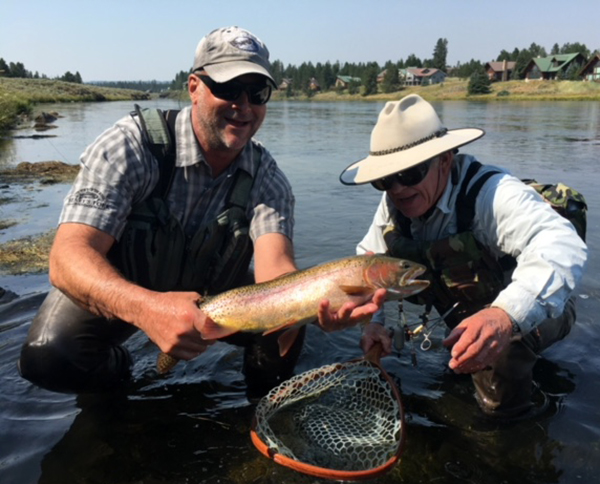 As was true of all Ranch fishing before 1 September, the Early Summer gave us very few shots at big fish. None of my clients landed three rainbows. It is the first time I have not had at least one three fish guide trip in the Early Season. It was an omen for how poor the year would be.
As was true of all Ranch fishing before 1 September, the Early Summer gave us very few shots at big fish. None of my clients landed three rainbows. It is the first time I have not had at least one three fish guide trip in the Early Season. It was an omen for how poor the year would be.
We did have interesting experiences in the early season. One was Flavs appearing as early as 16 June. We had many Green Drake spinners on 21 June; unfortunately, despite the many bugs, it was very tough to find large fish. While we didn’t have as many days of Brown Drake fishing as we have in recent years, we did have a couple of excellent hatches, one on 26 June.
We had good Flavs around 1 July; however, the low water kept the fish off the banks where so many typically hold to eat Flavs. I did not have any of the great Flav days— with multiple fish feeding on the banks from the Islands to above the Log Jam— that we had in 2016.
The Mid-Summer Season (7 July-27 July)
We saw decent numbers of Flavs in the Mid-Summer; however, we again had trouble finding fish—particularly in areas where we have traditionally found them. While the number of fish in the Harriman East section was far below what it has been in great years, there were occasional opportunities for good sight nymphing.
We had some days of good spinner fishing; however, we found ourselves going back to a relatively few places—like the Avenue of the Giants, the Bay of Pigs, the Hopper Bank, and the Whorehouse Pool.
When we saw flying black ants on the water in the mid-summer it was difficult to get fish to eat the Harrop size 16 black flying ants that have produced so many rainbows. The most logical explanation for why the fish became so tough on the ant imitations was because of the intense pressure imposed in the few places holding multiple fish.
The good caddis fishing of the mid-summers in my early years on the Ranch was nonexistent. My clients and I have taken a total of three fish on caddis imitations in the last three years. From 1983 until 1992, I took over 100 rainbows on the Lawsons’ spent partridge caddis fly alone.
The Late Summer (28 July-25 August)
The defining feature of the late summer was the poor honey ant fishing. The ants were not found in the areas in which they are usually abundant—such as in the Channels and the Flats above the Channels. I only found good numbers of honey ants on three days. In contrast, the average number of days I found honey ants for the years of 2015 and 2016 was nine. Also, I saw most of the honey ants later in the day, from 12:30 to 2:30, rather than the typical 10:30 to 12:30 period of good honey ant years.
Another negative was a continuation of poor PMD fishing. In my first two decades, The Late Summer always provided good PMD fishing; however, in 2017 we took no fish on them. If you had told me in the 1980s that I would land no fish on PMDs in the Late Summer of 2017, I would not have believed you.
Productive areas for rusty and callibaetis spinners during the Late Summer included, the Whorehouse Pool, the Avenue of the Giants, the Hopper Bank, the Meat Hole, the Bay of Pigs, and the Third Fence. As was the case all summer, when the fish were on spinners they were very difficult to hook. A few of my skilled clients cast to great fish for over two hours without hooking them.
Early Fall Season (26 August-15 September)
The fishing improved significantly as we moved into the early fall season. It was not until the 31 of August that I landed three good fish in a day. It is stunning to admit that from 15 June until 30 August my clients and I never landed three fish—that has never occurred before.
Starting on 31 August and continuing until 15 September, we had good numbers of hoppers, Trico duns and spinners, and Callibaetis spinners on the Hopper Bank, the Meat Hole, the Islands, the Avenue of the Giants, the Bay of Pigs, the Third Fence, and the Whorehouse Pool.
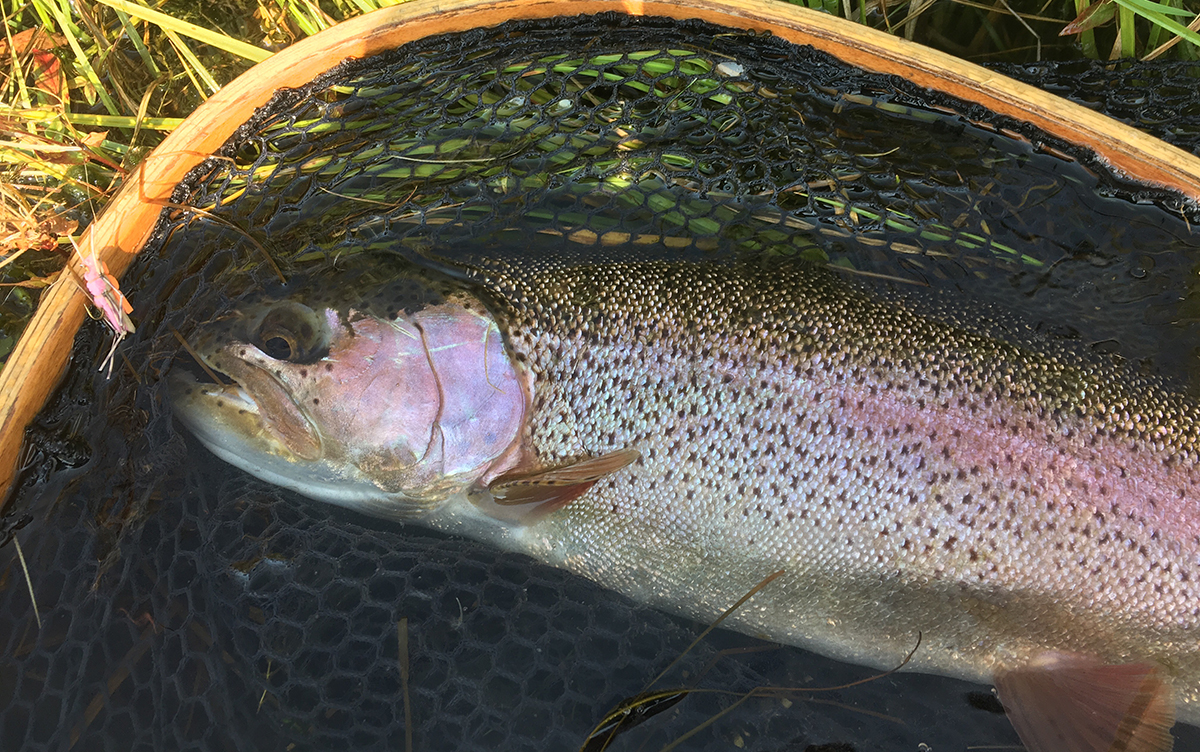
The number of hoppers in some of the Ranch fields was incredible—I have never seen so many as I walked to and from the river. I had six days between 31 August and 15 September when, fishing alone, I landed at least three fish on hoppers. Finally, we had several days with good hatches of blue wing olives—with a blanket hatch on the Hopper Bank on 14 September.
I shall add a caveat concerning the low numbers of fish landed during the season. A high percentage of great Ranch fish that are hooked are lost—particularly by clients new to the water. For the year, my clients landed only 22 percent of the fish they hooked and my average was 52 percent. In recent years, the heavy aquatic vegetation of August and September resulted in a dramatic increase in the loss of fish. An index of how much more difficult the landing of fish became was provided by a landing ratio of 65 percent I had with a superb five-weight Akimaru cane rod I fished for more than 100 hours during the Early and Mid-Summer seasons. Obviously, for my record to decline to 52 percent by 15 September, I had many days when I was landing less than half of the fish I hooked.
Fish Populations
A defining, and justifiably celebrated, feature of the fishery is we take many rainbows between 20 and 22.5 inches in length on dry flies.
In 2017, our largest fish was 22.5 inches long. (For the thirty-five year period, our largest fish was 24. 5 inches long.) My historical data indicate that very few rainbows are 23 inches long or longer. Only 23 of the 1,995 fish I have landed since 1983 have reached or exceeded 23 inches in length; however, 678 have been at least 20 inches long.
I saw only one fish with gill lice compared to over a dozen last year. We did have fish with gill ulcers. The ulcer is located
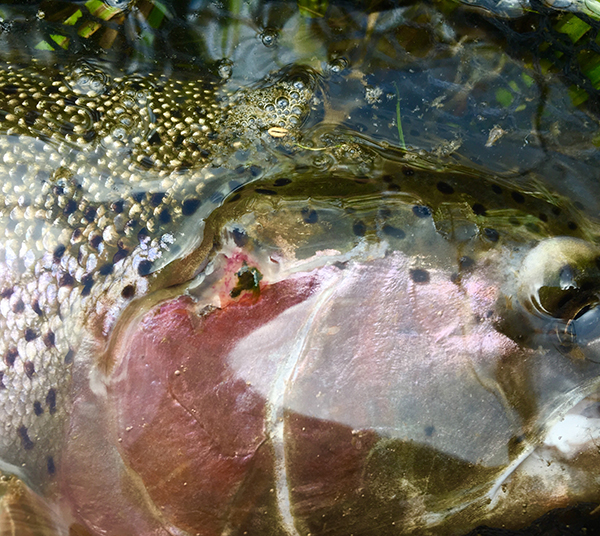
on the gill cover, or operculum. In some cases the tissue of the gill cover will be eroded and allow you to see the gills. The highest number of fish I have seen with the pathology in any year was three; however, I have seen it at least once every year. Every fish with gill ulcers has been large and I suspect they all are old. (I have attached a photograph of a fish with a gill ulcer that I took in 2017.)
We have seen a stunning decline in whitefish since the early 1990s. In the last six years, my clients and I have landed 472 rainbows. During the same period, we have not landed a whitefish. In the 1980s, we would frequently be frustrated when we cast brown drake imitations to rising rainbows because we could not keep them away from the many whitefish. I am confident the decline in whitefish is evidence of a fishery that has suffered significant habitat damage.
Reflections on My Data
My data are not the product of scientific research; however, they were recorded with discipline and honesty. For example, the comparisons I make between the fish we landed in 2016 and 2017 would be suspect if I had invested significantly more hours in 2016. Despite the allocation of more than 400 hours in both years, there were only three hours of variation in the fishing time invested in the two years.
I do not have a PhD in fisheries biology; however, I have a PhD If you harbor the misconception that a PhD degree assures that one will exclusively conduct astute, meaningful, well designed, and effectively implemented research, you are wrong; moreover, in the forty-two years I worked for, and with, other PhDs, I encountered more than a few who were lazy, selfish, and arrogant. Finally, do not harbor the flawed perception that all PhDs have superior intelligence. I know rod makers, fly shop owners, homemakers, and a professional fly tier who are as bright as any PhD I ever met.
If you are determined to learn as much as you can about a specific species of game or fish —as I was when collecting data for three books I wrote on the American Wild Turkey—who would you rather learn from: a PhD who is doing most of his research in a laboratory or office, or a bright and disciplined guy who has invested thousands of hours studying the birds in the field and passionately hunts them every day he can? I read data provided by biologists with PhDs; however, the most valuable insights I gleaned were from a Louisiana high school teacher, coach, and turkey call maker named Kenny Morgan who pursued the birds with relentless determination from the age of ten until he died in his early 60s, from contacting Agent Orange in Vietnam.
There are many lay people who have provided invaluable insights on environmental problems, including an example from the Harriman Ranch. One of the worst embarrassments in the recent history of attempts to protect the Ranch fishery is the failure of either the Harriman State Park or the HFF to address, in a timely manner, the deterioration of the irrigation canal at the Top of the Ranch.
It was a Ranch Regular, John Wilbrecht—who does not have a Ph.D. — who monitored, defined, and documented on his own time and with no financial support, the profound threats imposed by the canal. Yes, the HFF addressed the problem, but their action was tardy and initiated only as a result of John’s work.
The reason John’s findings were acted upon was because they were diligently studied by a special HFF board member who went beyond the normal expectations of his role and investigated, in the field, what Wilbrecht documented. The experience indicates how critical it is to have attentive, involved, well informed, board members willing to allocate time to examine data provided by anglers, assess their importance, and have the courage to demand that the problems defined be addressed.
There are other lay citizens who have defined serious fishery problems. An angler who visits the Ranch every summer told me about a physician on the Delaware River who refused to accept that a catastrophic problem involving the proliferation of parasites behind a dam could not be solved. The story is the MD invested huge amounts of time implementing research and provided findings that ultimately resulted in effective action being taken.
An example of potential help that might be provided on the Henry’s Fork by a lay person involves the efforts of Don Hodge. I fished the Ranch with Don in the 1980s. His attention to the Ranch has not waned. Don is not new to making efforts to protect great waters. He has been involved in many projects oriented to Silver Creek.
Don believes it is viable to address the problem of the silt that accumulates in Island Park Reservoir. The challenges of isolating the silt, and implementing the sobering task of removing it, are immensely more challenging than the simple effort of making repairs to a small irrigation canal; however, even if such action is expensive, what price is too high to protect the fishery? I would argue that investing dollars comparable to what was invested for the purchase and renovation of a better office building for HFF staff would be eminently reasonable.
Why Clients Return to the Ranch
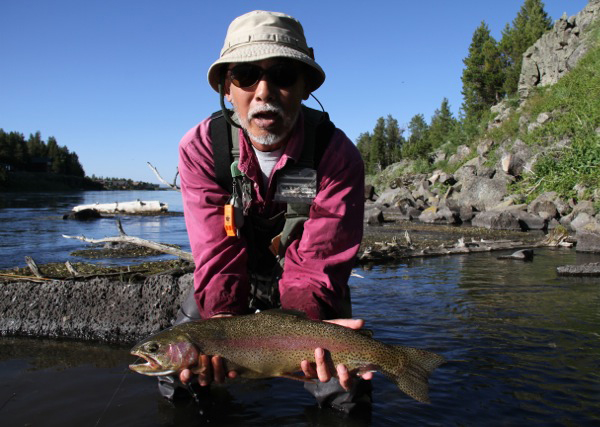
The Ranch pulls clients back because of what it means when a 20 inch class rainbow finally takes their well presented dry fly, or they hook a great fish while sight nymphing. Remember, some of those anglers had been fishing places where the angling challenges are no different than those at a kid’s fishing pond. The fishing scams are developing everywhere. I saw an article in The Bulletin of the prestigious, The Anglers Club of New York that attempted to make a case that the only way you can be thrilled by a trout in today’s world is to pursue stocked, and artificially fed, big fish. The argument was pathetic. I was tempted to tell the author to visit the Ranch where he would find wild rainbows that would thrill him.
Anglers from all over the world know the Ranch is special. The degree of difficulty implicit in consistently hooking 20 inch class Ranch fish on a dry fly can change a person’s life. It did mine.
We could soon reach a point when the decline in large fish will result in depriving even the most determined anglers of a reasonable number of targets. We should all recognize how dire the situation is.
Climate Change
The only time I fish in Montana, the state in which I live, is when I take my grandchildren to small streams. In 2017, my son-in-law gave a talk at a conservation meeting in Bozeman and several speakers addressed the negative implications climate change was having for Montana’s great rivers. I was shocked by the attention directed to the subject when I reflected on how infrequently I had heard the words “climate change” when talking to HFF employees, or seen the words in the “Voice of the River” publication.
My curiosity stimulated me to attend other meetings of Montanan fishery biologists, anglers, and conservationists. I was stunned by the data they had that addressed the impacts of climate change—particularly on fish, aquatic insects, stream flows, and water temperatures. While the data are preliminary, I found it provocative that a least one study suggested that climate change has had particularly deleterious implications for PMDs and caddis.
Last summer, I attended a HFF meeting Rob VanKirk offered at the Nature Conservancy’s Flat Ranch in which the implications of climate change for the Henry’s Fork were addressed. The informative meeting, held before a small but attentive audience, provided a review of the Foundation’s current research; however, none of the pressing concerns articulated at the Montana events were discussed.
Toward the end of the meeting, I asked Rob whether the Foundation had concerns comparable to those I had heard articulated in Montana. In the conclusion to his answer, Rob said, “If we can get some decent flows, I think we can have a viable fishery for another twenty years.”
I was stunned by the comment. As I drove back to Last Chance, I thought, “Would there be no Ranch fishing for my grandkids? I wondered if I might have misunderstood Rob. Thankfully, another Ranch regular had attended the meeting with me and I asked him if I had summed up what Rob has said correctly. My friend answered, “Rob said precisely what you indicated he said.”
How do you feel about having a twenty year window of fishing on the Ranch? The comment suggests any positive projections offered about the future of Ranch fishing should be viewed with concern.
Why So Few Walk / Wade Trips?
The scarcity of walk/wade Ranch trips may be the most powerful, clearly unbiased, indicator of the decline in our fishing. My introduction to the Ranch, in 1983, was provided by a week of guided trips Nell and I booked with Henry’s Fork Anglers. I had fly fished since I was a kid, but neither Nell nor I were skilled anglers. Five of our trips—four of which were walk/wades—were on the Harriman Ranch. We loved every day on the Ranch. How many times in the last five years has either Henry’s Fork Anglers or TroutHunter sent clients to the Ranch for walk/wade trips on five out of seven days they booked?
Another story that addresses the infrequency of walk/wade trips currently run on the Ranch is provided by a review of a single day of guide trips sent out by TroutHunter during the first decade of the twenty-first century. I ran one of either four or five walk/wade trips booked on the day exclusively by Japanese anglers. There were four guides and, at least, eight happy Japanese anglers that stopped by our cabin after the day.
How many walk/wade trips were run on the Ranch last summer as compared to guide trips to the Sheridan Ranch? Who would like to try to make a persuasive argument that Sheridan Ranch fishing is more challenging, affords a more spectacular setting, or can be compared favorably to the Harriman Ranch fishery in any meaningful way?
Last summer I saw two walk/wade guide trips being run from the Top of the Ranch to Osborne Bridge. I believe the infrequency of walk/wade trips provides support for why so many Ranch anglers are deeply concerned about the fishery.
Reflections on 2017 and the Future
After it became clear that our fish were concentrated in a relatively few areas of the Ranch, a few anglers said that too much pressure was being imposed on our fish. I respect the ethical concerns implicit in the argument, but my experience has convinced me our rainbows can protect themselves even when fishing pressure is intense—if that pressure is implemented in an ethical manner. If you limit yourself to dry flies, or sight nymphing, our rainbows will demonstrate they can avoid being hooked too often.
A different magnitude of threat is imposed if you drop nymphs off big dries, strip leaches, or throw streamers. I perceive those techniques to be unethical on the Ranch, and also capable of jeopardizing the health of our fish. The primary threat is that the fish can be hooked too often; in addition, large hooks can seriously injure even our largest fish. (I have found that using small, size 12, hoppers dramatically reduces the chance of injuring fish; moreover, I hook more rainbows on them than I do on larger hopper imitations.)
If guides have their clients fishing hoppers from a boat, they will increase the chances of stressing fish as a function of the boat allowing them to move rapidly from one productive bank to the next, easily following hooked fish, moving with stealth when approaching fish, and, perhaps most importantly, conserving the clients’ energy. It is imperative to appreciate our big fish numbers are down and do what we can to reduce pressure on our fish. One way to accomplish that is to limit the aggressive, albeit legal, techniques.
It is particularly important to be honest and candid about the magnitude of the problems facing the Ranch fishery. To argue, or imply, the sacred eight and one half miles of water is not facing very serious threats will assure that no long term solutions will be achieved.
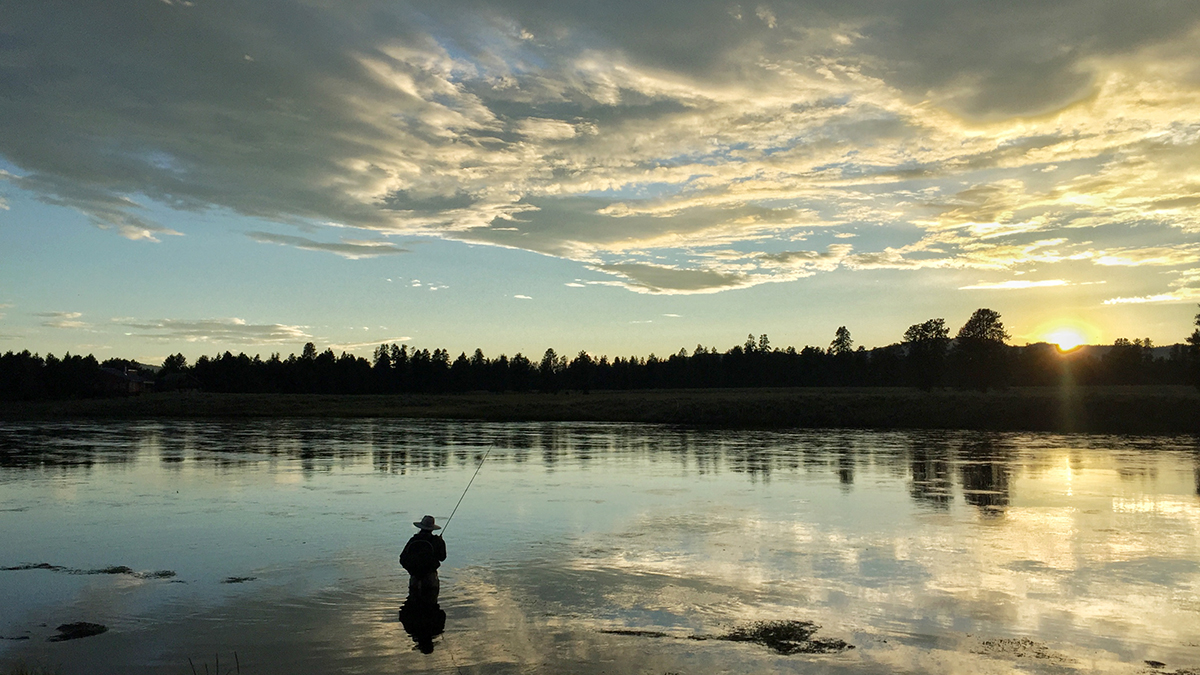

4 Comments
Mike Johnston
In the early eighties, mid-July we would enter the river below Osborne Bridge at around 6PM in a full sweat because of the many layers needed. At 10:30 we would climb out of the river shivering nearly uncontrollably. In the meantime the caddis hatch would be overwhelming with the surface dotted like a golf ball with rises. Additionally, back then we released nearly as many white fish as rainbows. We have fished this beautiful river continuously since 1983. The last substantial caddis hatch that I recall was in 86' at the log jamb. Back then, Flavs were a rival evening hatch starting about an hour before the caddis. The river and its tender occupants have endured significant hardship over the last three decades, much at the hands and decisions made by our species. Can we win the day against those who see no reason for adjusted stewardship? Maybe, but we are facing the impact of global warming on this river and multiple others throughout Rocky Mountain West - and it is not easy to be optimistic.
Jeff Lefebvre
This was extremely enlightening. I have only fished the ranch once- over 20 years ago. I have always wanted to return. I had heard that the Henry's Fork was experiencing a significant "comeback" and have been searching for details about just what was meant by that. Needless to say, this piece provided quite a bit of data to offset mere rumor with fact and first hand experience. Rather than deter me from a return visit, I now feel a sense of urgency to get there even sooner and see for myself just how the fishery stacks up to my first visit-
Gordon Rattray
Very valuable summary of fishing the Ranch last year and of problems facing the Ranch now and in the future. Thank you.
Larry Lightner
I have only fishing the Harriman-Last Chance area for about 6 or 7 years but I agree with everything that you mentioned. I only wade fish and typically use nothing larger than an 18 and frequently use 20's and 22's so my catch is around 25/30%. This last year I noticed there were not as many 20+ inch fish although there did appear to be a good population of mid sized fish. The biggest thing I noticed, which you mentioned, was the erratic and inconsistent hatches. In addition to the issues that you mentioned, I also wonder about the effect of increasing fertilizer/pesticide use resulting from increased population in the area. I have talked to several people about this including some of the HFF data collectors and it seems there is not a lot of information. This would affect plant and fish live depending on the specific product being used. This was an excellant piece and, as I said, my observations are the same as yours. Larry Lightner